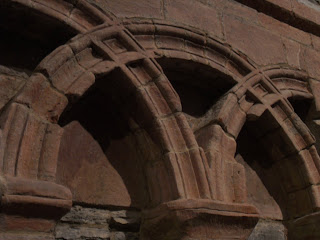(Note: "Shorkney" is not a real word. We're just using it to write about our recent trip to Aberdeen, Orkney, and Shetland.)
The Viking Age
After about 800 AD, the Vikings began to settle in Orkney and Shetland, though it's unclear whether they conquered the Picts who were already there or simply drove them back to the Scottish mainland.
Shetland and Orkney--but especially Orkney--were extremely important during the Viking Age. First, they lay at the geographical center of Viking maritime culture, situated at the crossroads of the North Sea, the Norwegian Sea, and the Atlantic Ocean.
Second, Orkney included some of the most fertile land in the region, and so developed into one of the richest of the Norse provinces. In fact, as I mentioned in our post on Maes Howe, Orkney is home to the largest collection of Norse runes outside Scandinavia, and the Orkneyinga saga is one of the most important surviving pieces of Viking literature. The bits of these documents I've read are really quite funny: Maes Howe, for instance, is covered with silly boasts about the carvers being the best carvers of runes in the world, and at least one note that seems to compare another Viking's woman to a rabid dog.
Norse culture remains strong in Orkney and Shetland to this day. Though debt forced the king of Norway to give Orkney to the Scottish in 1468, and the Scottish came to dominate Shetland culturally and economically at about the same time, many people in the Northern Isles consider themselves to be about as much Scandinavian as Scottish. There is definitely something Scandinavian about the Shetland dialect, and the modern flags of Orkney (top) and Shetland (bottom) were specifically designed to reflect this Norse heritage.
Compare this to the Norwegian Flag, below, which features the same off-center cross and a similar color scheme.
St. Magnus Cathedral
St. Magnus Cathedral, in Kirkwall, Orkney, is the greatest surviving monument to the Viking Age in the Northern Isles.
The cathedral is dedicated to St. Magnus, a local Viking ruler who was martyred in the 12th century for refusing to participate in a bloody raid in Wales. The oldest parts of the cathedral were built shortly thereafter, in the Romanesque style. This style is characterized by round arches, like upside-down U's, and darker interiors than the later Gothic style (think York Minster or Notre Dame).
The Romanesque style is the same used in Durham Cathedral in England, as well as on Lindisfarne.
You can see the round arches on either side of the photo below.
You'll notice that the window at the back, however, is a pointed or "vaulted" arch, in the later Gothic style. The ceiling is also vaulted, as are all the windows in the towers. This is because construction on the cathedral continued until the early 1900s. In fact, there's a sign on the building across the street with a diagram of the exterior of the cathedral showing when each section was built:
As it turns out, some of the most "Gothic" features are actually Victorian, part of the Gothic Revival at the end of the 19th century that gave us college campuses like Yale's.
St. Magnus also has some typically Norse features, such as a longboat on the altar . . .
. . . and interlocking arches, which some have argued are an intermediate stage between rounded arches and vaulted arches.
Bonus: There's a Norwegian consulate in Orkney! It must be one of the smallest towns in the world to host a foreign consulate.
Subscribe to:
Post Comments (Atom)













No comments:
Post a Comment